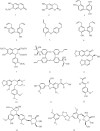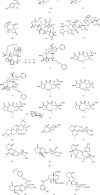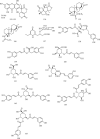Natural Products: Review for Their Effects of Anti-HBV
- PMID: 33376721
- PMCID: PMC7746453
- DOI: 10.1155/2020/3972390
Natural Products: Review for Their Effects of Anti-HBV
Abstract
Hepatitis B is a global infectious disease, seriously endangering human health. Currently, there are mainly interferons and nucleoside analogues treatment of hepatitis B in the clinic, which have certain therapeutic effects on hepatitis B, but their side effects and drug resistance are increasingly prominent. Therefore, it is urgently needed to discover and develop new anti-HBV drugs, especially natural products, which have novel, high efficiency, and low toxicity anti-HBV compounds with novel antiviral mechanisms. In this manuscript, the natural products (polysaccharides and 165 compounds) with the activity of antihepatitis B virus are discussed according to their chemical classes, including 14 phenylpropanoids, 8 flavonoids,12 xanthones, 13 anthroquinones, 47 terpenoids, 6 alkaloids, 15 enediynes, 11 aromatics, 18 phenylalanine dipeptides compounds, and 13 others. In addition, the anti-HBV mechanism and targets of natural product were also discussed. The aim of this review is to report new discoveries about anti-HBV natural products and to provide reference for researchers.
Copyright © 2020 Xuqiang Liu et al.
Conflict of interest statement
The authors declare no conflict of interest.
Figures











References
-
- Safioleas M., Lygidakis N. J., Manti C. Hepatitis B today. Hepato-Gastroenterology. 2007;54(74):545–548. - PubMed
-
- World Health Organisation. Hepatitis B, factsheet, No.204. 2014. https://www.who.int/Mediacentre/factsheets/fs204/en/1.
-
- Mason W. S. Cancer Associated Viruses. New York: Springer-Verlag New York Inc.; 2012.
-
- Nassal M. New insights into HBV replication: new opportunities for improved therapies. Future Virology. 2009;4(1):55–70. doi: 10.2217/17460794.4.1.55. - DOI
Publication types
MeSH terms
Substances
LinkOut - more resources
Full Text Sources

